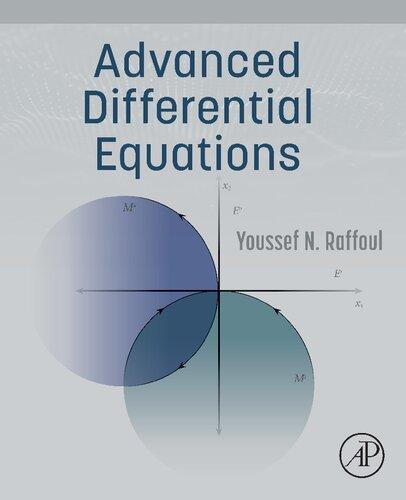(eBookPDF)ResearchMethods,Design,andAnalysis 13thEdition

https://ebookmass.com/product/ebook-pdf-research-methodsdesign-and-analysis-13th-edition/

Television Sports Production 5th Edition, (Ebook PDF)
https://ebookmass.com/product/television-sports-production-5thedition-ebook-pdf/
ebookmass.com
Economies of Literature and Knowledge in Early Modern Europe: Change and Exchange Subha Mukherji
https://ebookmass.com/product/economies-of-literature-and-knowledgein-early-modern-europe-change-and-exchange-subha-mukherji/
ebookmass.com
Advanced Differential Equations 1st Edition Youssef Raffoul
https://ebookmass.com/product/advanced-differential-equations-1stedition-youssef-raffoul/
ebookmass.com
International Human Rights Law 3rd Edition Daniel Moeckli



https://ebookmass.com/product/international-human-rights-law-3rdedition-daniel-moeckli/
ebookmass.com
Escaping Valentine’s Day Barth
https://ebookmass.com/product/escaping-valentines-day-barth/
ebookmass.com


Familial Feeling: Entangled Tonalities in Early Black
Atlantic Writing and the Rise of the British Novel 1st ed.
Edition Elahe Haschemi Yekani
https://ebookmass.com/product/familial-feeling-entangled-tonalitiesin-early-black-atlantic-writing-and-the-rise-of-the-british-novel-1sted-edition-elahe-haschemi-yekani/
ebookmass.com


3.Operationalizationof Constructs9
4.Replication10
5.EvidenceNot Proof 10
5.TheRoleof TheoryinScientificResearch11
6.Objectivesof Psychological Research13
1.Description13
2.Explanation13
3.Prediction13
4.Control or Influence14
7.Pseudoscience14
1.Summary15
2.KeyTermsandConcepts16
3.RelatedInternet Sites16
4.PracticeTest 16
5.ChallengeExercises17
2.2ResearchApproachesandMethodsof DataCollection18
1.VariablesinQuantitativeResearch19
2.Experimental Research21
3.Causation22
1.Cause22
1.Tests34
2.Questionnaires34
3.Interviews35
4.FocusGroups35
5.Observation36
6.Existingor SecondaryData37
1.Summary39
2.KeyTermsandConcepts40
3.RelatedInternet Sites40
4.PracticeTest 40
5.ChallengeExercises41
2.Part II PlanningtheResearchStudy42
1.3IdentifyingResearchQuestionsandFormingHypotheses42
1.Sourcesof ResearchIdeas43
1.EverydayLife43
2.Practical Issues43
3.Past Research44
4.Theory44
2.Breadthof ResearchIdeas45
1.IdeasNot Capableof ScientificInvestigation46
3.Reviewof theLiterature46
1.GettingStarted47
2.DefiningObjectives47
3.ConductingtheSearch47
1.Books48
2.Psychological Journals48
3.Computerizedor ElectronicDatabases48
4.Internet Resources51
4.ObtainingResources53
5.Additional InformationSources53
4.Feasibilityof theStudy54
5.Purposeof theResearch55
1.DefiningtheResearchQuestion55
2.Specificityof theResearchQuestion55
6.FormulatingHypotheses56
1.Summary57
2.KeyTermsandConcepts58
3.RelatedInternet Sites58
4.PracticeTest 58
5.ChallengeExercises59
6.Confidentiality,Anonymity,andtheConcept of Privacy75
5.Ethical IssuesinElectronicResearch76
1.InformedConsent andInternet Research76
2.PrivacyandInternet Research77
3.DebriefingandInternet Research77
6.Ethical IssuesinPreparingtheResearchReport 78
1.Authorship78
2.WritingtheResearchReport 79
7.Ethicsof Animal (Nonhuman) Research80
1.SafeguardsintheUseof Animals80
2.Animal ResearchGuidelines80
1.I.Justificationof theResearch80
2.II.Personnel 81
3.III.CareandHousingof Animals81
4.IV.Acquisitionof Animals81
5.V.Experimental Procedures81
6.VI.FieldResearch82
7.VII.Educational Useof Animals82
1.Summary83
2.KeyTermsandConcepts84
3.RelatedInternet Sites85
4.PracticeTest 85
5.ChallengeExercises85
3.Part III Foundationsof Research87
1.5MeasuringVariablesandSampling87
1.DefiningMeasurement 88
1.Scalesof Measurement 88
1.Nominal Scale88
2.Ordinal Scale89
3.Interval Scale89
4.RatioScale89
2.PsychometricPropertiesof GoodMeasurement 90
1.Overviewof ReliabilityandValidity90
2.Reliability90
1.Test–Retest Reliability90
2.Equivalent-FormsReliability90
3.Internal ConsistencyReliability91
4.Interrater Reliability91
3.Validity91
1.ValidityEvidenceBasedonContent 92
2.ValidityEvidenceBasedonInternal Structure93
3.ValidityEvidenceBasedonRelationstoOther Variables93
4.UsingReliabilityandValidityInformation95
5.Sourcesof InformationAbout Tests95
3.SamplingMethods95
1.TerminologyUsedinSampling96
2.Random SamplingTechniques97
1.SimpleRandom Sampling97
2.StratifiedRandom Sampling99
3.Cluster Random Sampling101
4.SystematicSampling101
3.Nonrandom SamplingTechniques102
4.Random SelectionandRandom Assignment 103
5.DeterminingtheSampleSizeWhenRandom SamplingIs Used104
6.SamplinginQualitativeResearch105
1.Summary106
2.KeyTermsandConcepts107
3.RelatedInternet Sites107
4.PracticeTest 108
5.ChallengeExercises108
2.6ResearchValidity109
1.Overviewof Four Major Typesof Validity110
2.Statistical ConclusionValidity110
3.Construct Validity111
1.ThreatstoConstruct Validity112
1.Participant ReactivitytotheResearchSituation 112
2.Researcher Effects113
4.Internal Validity115
1.ThreatstoInternal Validity116
1.History118
2.Maturation120
3.Instrumentation120
4.Testing120
5.RegressionArtifact 121
6.Attrition121
7.Selection122
8.AdditiveandInteractiveEffects122
5.External Validity123
1.PopulationValidity124
2.Ecological Validity125
3.Temporal Validity125
4.Treatment VariationValidity125
5.OutcomeValidity126
6.RelationshipBetweenInternal andExternal Validity126
1.Summary127
2.KeyTermsandConcepts128
3.RelatedInternet Sites128
4.PracticeTest 128
5.ChallengeExercises129
3.7Control TechniquesinResearch131
1.Control TechniquesCarriedOut at theBeginningof the Study133
2.Random Assignment 133
3.Matching136
1.MatchingbyHoldingVariablesConstant 136
2.MatchingbyEquatingParticipants137
4.BuildingtheExtraneousVariableintotheDesign138
5.Statistical Control 139
6.Control TechniquesCarriedOut DuringtheStudy139
7.Counterbalancing139
3.SampleSize153
1.Power 153
4.Apparatusand/or Instruments156
5.Procedure157
1.Schedulingof ResearchParticipants157
2.Consent toParticipate158
3.Instructions159
4.DataCollection159
5.Debriefing159
1.DebriefingFunctions159
2.HowtoDebrief 160
6.Pilot Study161
1.Summary162
2.KeyTermsandConcepts163
3.RelatedInternet Site163
4.PracticeTest 163
5.ChallengeExercise164
4.Part IVExperimental Methods165
1.9Experimental ResearchDesign165
1.WeakExperimental ResearchDesigns167
1.One-GroupPosttest-OnlyDesign168
2.One-GroupPretest–Posttest Design168
3.Posttest-OnlyDesignwithNonequivalent Groups169
2.StrongExperimental ResearchDesigns170
3.Between-ParticipantsDesigns172
1.Posttest-OnlyControl-GroupDesign172
1.StrengthsandWeaknessesof thePosttest-Only Control-GroupDesign173
4.Within-ParticipantsDesigns175
1.StrengthsandWeaknessesof Within-Participants Designs175
5.MixedDesigns(i.e.,Combinationof BetweenandWithin) 176
1.Pretest–Posttest Control-GroupDesign177
2.AdvantagesandDisadvantagesof IncludingaPretest 177
6.Factorial Designs179
1.Factorial DesignsBasedonWithin-Participants Independent Variables184
2.Factorial DesignsBasedonaMixedModel 185
3.Natureof Independent VariablesinFactorial Designs 186
4.StrengthsandWeaknessesof Factorial Designs186
7.HowtoChooseor Construct theAppropriateExperimental Design188
1.Summary189
2.KeyTermsandConcepts190
3.RelatedInternet Sites190
4.PracticeTest 190
5.ChallengeExercises191
2.10Quasi-Experimental Designs193
1.Quasi-Experimental Designs194
2.Nonequivalent ComparisonGroupDesign196
1.OutcomeswithRival Hypotheses198
1.OutcomeI: IncreasingControl andExperimental Groups198
2.OutcomeII: Experimental-Group-Higher-thanControl-Group-at-Pretest Effect 199
3.OutcomeIII: Experimental-Group-Lower-thanControl-Group-at-Pretest Effect 199
4.OutcomeIV: Crossover Effect 200
2.RulingOut ThreatstotheNonequivalent Comparison GroupDesign200
3.Causal Inferencefrom theNonequivalent Comparison GroupDesign202
3.Time-SeriesDesign202
2.TherapeuticCriterion224
5.Rival Hypotheses224
1.Summary225
2.KeyTermsandConcepts226
3.RelatedInternet Sites226
4.PracticeTest 226
5.ChallengeExercises227
5.Part VNonexperimental,Qualitative,andMixedMethodsResearch 228
1.12Nonexperimental QuantitativeResearchMethods228
1.Independent VariablesandDependent Variables inNonexperimental QuantitativeResearch229
2.TheBradfordHill Criteriafor Causation230
3.Techniquesof Control inNonexperimental Quantitative Research232
1.Matching232
2.HoldingtheExtraneousVariableConstant 234
3.Statistical Control 234
4.Nonexperimental DesignsBasedontheTimeDimension 235
1.Cross-Sectional andLongitudinal Designs235
2.Evaluationof Cross-Sectional andLongitudinal Designs237
5.Nonexperimental ResearchDesignsbasedonResearch Purpose238
1.DescriptiveNonexperimental QuantitativeResearch 238
2.PredictiveNonexperimental QuantitativeResearch239
3.ExplanatoryNonexperimental QuantitativeResearch 240
1.Summary244
2.KeyTermsandConcepts245
3.RelatedInternet Sites245
4.PracticeTest 245
5.ChallengeExercises246
2.13SurveyResearch247
1.Purposesof SurveyResearch249
2.StepsinSurveyResearch250
3.Cross-Sectional andLongitudinal Designs251
4.SelectingaSurveyDataCollectionMethod252
5.ConstructingandRefiningaSurveyInstrument 254
1.Principle1.WriteItemstoMatchtheResearch Objectives255
2.Principle2.WriteItemsThat AreAppropriateand Meaningful for theRespondentstoBeSurveyed255
3.Principle3.WriteShort,SimpleQuestions256
4.Principle4.AvoidLoadedandLeadingQuestions256
5.Principle5.AvoidDouble-BarreledQuestions256
6.Principle6.AvoidDoubleNegatives257
7.Principle7.DetermineWhether Closed-Endedand/or Open-EndedQuestionsAreNeeded257
8.Principle8.Construct MutuallyExclusiveand ExhaustiveResponseCategoriesfor ClosedEndedQuestions258
9.Principle9.Consider theDifferent Typesof ClosedEndedResponseCategoriesRatingScales258
1.BinaryForcedChoice260
2.Rankings260
3.Checklists261
10.Principle10.UseMultipleItemstoMeasureComplex orAbstract Constructs261
1.SemanticDifferential 261
2.Likert Scaling262
11.Principle11.MakeSuretheQuestionnaireIsEasyto Usefrom theBeginningtotheEnd263
1.Orderingof Questions263
2.ContingencyQuestions263
3.QuestionnaireLength264
4.ResponseBias264
12.Principle12.Pilot Test theQuestionnaireUntil It Is Perfected265
6.SelectingYour SurveySamplefrom thePopulation265
7.PreparingandAnalyzingYour SurveyData267
1.Summary268
2.KeyTermsandConcepts268
3.RelatedInternet Sites268
4.PracticeTest 269
5.ChallengeExercises269
3.14QualitativeandMixedMethodsResearch270
1.Major Characteristicsof QualitativeResearch272
2.ResearchValidityinQualitativeResearch273
1.DescriptiveValidity274
2.Interpretiveor EmicValidity274
3.Theoretical Validity274
4.Internal (Causation) Validity274
5.External (Generalizing) Validity275
3.Four Major QualitativeResearchMethods276
1.Phenomenology276
1.Phenomenological DataCollectionandData Analysis277
2.Phenomenological Report Writing278
2.Ethnography279
1.EthnographicDataCollectionMethods280
2.Entry,GroupAcceptance,andFieldwork280
3.DataAnalysisandReport Writing281
3.CaseStudyResearch282
1.DataCollectioninCaseStudyResearch282
2.CaseStudyDesigns282
3.CaseStudyDataAnalysisandReport Writing283
4.GroundedTheory283
1.DataCollectioninGroundedTheoryResearch 285
2.GroundedTheoryDataAnalysisandReport Writing285
4.MixedMethodsResearch286
5.ResearchValidityinMixedMethodsResearch287
6.MixedMethodsDesigns289
1.Summary292
2.KeyTermsandConcepts293
3.RelatedInternet Sites293
4.PracticeTest 294
5.ChallengeExercises294
6.Part VI AnalyzingandInterpretingData295
1.15DescriptiveStatistics295
1.DescriptiveStatistics296
2.FrequencyDistributions298
3.GraphicRepresentationsof Data299
1.Bar Graphs299
2.Histograms300
3.LineGraphs300
4.Scatterplots302
4.Measuresof Central Tendency304
1.Mode304
2.Median304
3.Mean304
5.Measuresof Variability305
1.Range306
2.VarianceandStandardDeviation306
3.StandardDeviationandtheNormal Curve306
1. z scores307
6.ExaminingRelationshipsAmongVariables309
1.UnstandardizedandStandardizedDifference BetweenGroupMeans309
2.CorrelationCoefficient 310
1.Partial CorrelationCoefficient 315
3.RegressionAnalysis315
4.ContingencyTables318
1.Summary320
2.KeyTermsandConcepts320
3.RelatedInternet Sites320
4.PracticeTest 321
5.ChallengeExercises321
2.16Inferential Statistics322
1.SamplingDistributions323
2.Estimation325
3.HypothesisTesting327
1.Directional AlternativeHypotheses331
2.Reviewof theLogicof HypothesisTesting332
3.Hypothesis-TestingErrors332
2.Preparationof theResearchReport 363
1.WritingStyle364
2.Language365
1.Specificity365
2.Labels365
3.Participation366
4.SpecificIssues366
3.Editorial Style367
1.Italics367
2.Abbreviations367
3.Headings367
4.Quotations368
5.Numbers368
6.Physical Measurements368
7.Presentationof Statistical Results368
8.Tables368
9.Figures369
10.FigureLegendsandCaptions370
11.FigurePreparation370
12.ReferenceCitations370
